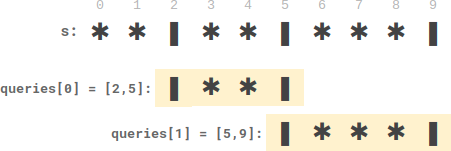- {x}
- Number of Valid Words in a Sentence
- Next Greater Numerically Balanced Number
- Count Nodes With the Highest Score
- Parallel Courses III
- The Category of Each Member in the Store
- Minimum Cost to Separate Sentence Into Rows
- Kth Distinct String in an Array
- Two Best Non-Overlapping Events
- Plates Between Candles
- Number of Valid Move Combinations On Chessboard
- Smallest Index With Equal Value
- Find the Minimum and Maximum Number of Nodes Between Critical Points
- Minimum Operations to Convert Number
- Check if an Original String Exists Given Two Encoded Strings
- Number of Spaces Cleaning Robot Cleaned
- Count Vowel Substrings of a String
- Vowels of All Substrings
- Read More...

Plates Between Candles
There is a long table with a line of plates and candles arranged on top of it. You are given a 0-indexed string s consisting of characters '*' and '|' only, where a '*' represents a plate and a '|' represents a candle.
You are also given a 0-indexed 2D integer array queries where queries[i] = [lefti, righti] denotes the substring s[lefti...righti] (inclusive). For each query, you need to find the number of plates between candles that are in the substring. A plate is considered between candles if there is at least one candle to its left and at least one candle to its right in the substring.
- For example,
s = "||**||**|*", and a query[3, 8]denotes the substring"*||**|". The number of plates between candles in this substring is2, as each of the two plates has at least one candle in the substring to its left and right.
Return an integer array answer where answer[i] is the answer to the ith query.
Example 1:

Input: s = "**|**|***|", queries = [[2,5],[5,9]] Output: [2,3] Explanation: - queries[0] has two plates between candles. - queries[1] has three plates between candles.
Example 2:

Input: s = "***|**|*****|**||**|*", queries = [[1,17],[4,5],[14,17],[5,11],[15,16]] Output: [9,0,0,0,0] Explanation: - queries[0] has nine plates between candles. - The other queries have zero plates between candles.
Constraints:
3 <= s.length <= 105sconsists of'*'and'|'characters.1 <= queries.length <= 105queries[i].length == 20 <= lefti <= righti < s.length
Solution Explanation
This problem asks to find the number of plates between candles for each query range in a string. The solution leverages prefix sums and pre-computed arrays to efficiently answer multiple queries.
Approach:
-
Prefix Sum: A
presumarray is created to store the cumulative sum of plates encountered so far.presum[i]represents the total number of plates from index 0 toi-1. This allows for constant-time calculation of the number of plates in any range. -
Nearest Candle Arrays: Two arrays,
leftandright, are created.left[i]stores the index of the nearest candle to the left of indexi, andright[i]stores the index of the nearest candle to the right of indexi. These arrays are computed using single linear scans of the string. -
Query Processing: For each query
[left_i, right_i]:- The nearest candles to the left of
left_i(i) and to the right ofright_i(j) are found using theleftandrightarrays. - If both
iandjare valid (meaning candles exist within the query range andi < j), then the number of plates between these candles is calculated aspresum[j] - presum[i + 1]. This is the efficient part enabled by the prefix sum.
- The nearest candles to the left of
Time Complexity Analysis:
- Creating
presumarray: O(N), where N is the length of the string. - Creating
leftandrightarrays: O(N) each, for a total of O(N). - Processing queries: O(Q), where Q is the number of queries. Each query takes constant time O(1) due to the pre-computed arrays.
Therefore, the overall time complexity is O(N + Q).
Space Complexity Analysis:
presum,left,rightarrays: O(N) each.ansarray: O(Q).
The overall space complexity is O(N + Q).
Code Explanation (Python3):
class Solution:
def platesBetweenCandles(self, s: str, queries: List[List[int]]) -> List[int]:
n = len(s)
presum = [0] * (n + 1) # Prefix sum array
for i, c in enumerate(s):
presum[i + 1] = presum[i] + (c == '*')
left, right = [0] * n, [0] * n #Nearest candle arrays
l = r = -1
for i, c in enumerate(s):
if c == '|':
l = i
left[i] = l
for i in range(n - 1, -1, -1):
if s[i] == '|':
r = i
right[i] = r
ans = [0] * len(queries) #result array
for k, (l, r) in enumerate(queries):
i, j = right[l], left[r] #get nearest candles for each query
if i >= 0 and j >= 0 and i < j:
ans[k] = presum[j] - presum[i + 1] #calculate plates between
return ans
The Java, C++, and Go code follow a very similar structure and logic to the Python code, differing only in syntax and data structure implementations. The core idea of prefix sum and pre-computed arrays for efficient query processing remains the same across all languages.